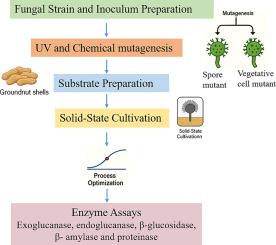米曲霉NCIM 637的化学诱变与紫外诱变的比较评价及诱变后工艺优化
Q1 Environmental Science
引用次数: 0
摘要
本研究评价了化学诱变和紫外诱变对米曲霉NCIM 637的影响,以提高花生壳固态发酵(SSF)下纤维素水解酶的产量。化学诱变产生了最一致的改进。经化学处理的营养细胞突变体M4代谢活性增加58.7%,酶产量大幅增加:内切葡聚糖酶(222.5 IU/gDW, 77.9%)、外葡聚糖酶(238 IU/gDW, 62.5%)、β-葡萄糖苷酶(560.7 IU/gDW, 61.9%)、β-木聚糖酶(652.8 IU/gDW, 55.4%)、β-淀粉酶(221.4 IU/gDW, 48.7%)和蛋白酶(196.6 IU/gDW,比WT高2.1倍)。紫外线诱变已被证明比化学诱变引起更多的选择性反应。营养细胞突变体M1表现出最大的改善,代谢活性提高了85.3%,同时β-木聚糖酶和蛋白酶活性也有所提高。统计分析证实诱变剂类型和孵育时间有显著影响(p < 0.001)。RSM模型提供了较强的预测拟合(R2 = 0.93-0.97),期望指数为>;0.95。工艺优化进一步提高了β-木聚糖酶(70.1%)和内切葡聚糖酶(61.96%)的收率。总的来说,化学诱变产生了广谱和稳定的改善,而紫外线照射选择性地刺激了特定的酶途径。这些结果展示了一种可扩展的方法,通过优化真菌诱变和SSF来实现农业残留物的增值,促进了可持续酶生产的工业应用。本文章由计算机程序翻译,如有差异,请以英文原文为准。

Comparative evaluation of chemical and UV mutagenesis with post-mutagenesis process optimization for enhanced cellulolytic enzyme production by Aspergillus oryzae NCIM 637
This study evaluated the effects of chemical and UV mutagenesis on Aspergillus oryzae NCIM 637 to enhance cellulolytic enzyme production under solid-state fermentation (SSF) using groundnut shells. Chemical mutagenesis has produced the most consistent improvements. The chemically treated vegetative cell mutant M4 showed a 58.7 % increase in metabolic activity and substantial gains in enzyme yields: endoglucanase (222.5 IU/gDW, 77.9 %), exoglucanase (238 IU/gDW, 62.5 %), β-glucosidase (560.7 IU/gDW, 61.9 %), β-xylanase (652.8 IU/gDW, 55.4 %), β-amylase (221.4 IU/gDW, 48.7 %), and proteinase (196.6 IU/gDW, 2.1-fold over WT). UV mutagenesis has been shown to elicit more selective responses than chemical mutagenesis. The vegetative cell mutant M1 showed the highest improvement, with an 85.3 % increase in metabolic activity, alongside elevated β-xylanase and proteinase activities. Statistical analysis confirmed the significant effects of mutagen type and incubation time (p < 0.001). RSM modeling provided strong predictive fits (R2 = 0.93–0.97) with desirability indices of >0.95. Process optimization further increased the yields, particularly for β-xylanase (70.1 %) and endoglucanase (61.96 %). Overall, chemical mutagenesis generated broad-spectrum and stable improvements, whereas UV irradiation selectively stimulated specific enzymatic pathways. These results demonstrate a scalable approach for valorizing agro-residues through optimized fungal mutagenesis and SSF, advancing sustainable enzyme production for industrial applications.
求助全文
通过发布文献求助,成功后即可免费获取论文全文。
去求助
来源期刊

Bioresource Technology Reports
Environmental Science-Environmental Engineering
CiteScore
7.20
自引率
0.00%
发文量
390
审稿时长
28 days
 求助内容:
求助内容: 应助结果提醒方式:
应助结果提醒方式:


